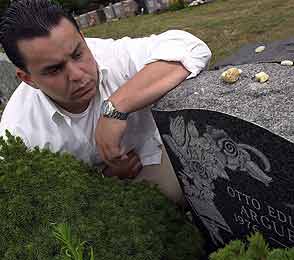| MEMBERS LOGIN | NEW USERS REGISTER | ||
 |
| News | Sports | Business | Entertainment | Photos | Shopping | NY Newsday.com |
|
Long
Island | New York
City | Nation |
World |
Health/Science |
State |
Obituaries |
Columnists Student Briefing | Schools | Crime & Courts | Election 2004 | LI Life | Corrections  Sunday, October 17, 2004 Sunday, October 17, 2004
LI's war against gangs
Staff Writers In the apartment complex where relatives of gang murder
victim Olivia Mendoza continue to mourn, a 17-year-old boy in loose
pants cursed freely last week and recalled the street fights he has
so far won.
The teen with broad shoulders and closely cut hair is not a gang member. But he says he has twice battled them with his fists -- once at the age of 15 and again last year -- when they attempted to violently recruit him. He swears in frustration, because no matter how bravely he resists his tormentors they persist with force and psychological ploys. "Then they try to tell you 'If you join, we'll be a family,'" he said at the complex in Hempstead. "I was just like 'It's all . It's not true.'" Long before Tuesday's arrest of six suspected MS-13 leaders in the slayings of alleged associates Genaro Venegas and Olivia Mendoza, pockets of the Nassau and Suffolk communities where the victims resided have struggled with a growing specter of gangs. Though gang violence has surfaced in affluent communities on Long Island with Mendoza's body discovered in Old Westbury and a man walking home from a Lynbrook train station killed last September, police say it disproportionately besets working class neighborhoods such as Hempstead, Uniondale, Roosevelt, Brentwood and Central Islip. Nassau County Police Det. Sgt. Gregory Quinn, deputy commander of the Special Intelligence Squad, estimated recently that some 2,000 to 3,000 gang members reside in the county, compared to a handful that first became active in the early 1990s. Suffolk police said because of the mercurial nature of gang membership they no longer formally estimate numbers. But retired Suffolk County Police Det. Wes Daily said he officially estimated in 2002 that there were 1,500 gang members in the jurisdiction, up from the 200 he estimated as recently as 1997. Daily, a former head of the Criminal Intelligence Section who continues to lecture nationally on gangs, said the number could be above 2,000 today. Daily said mere teens often bear the brunt of gang aggression near buildings like the 17-year-old's apartment complex, which has graffiti scrawled on its entrance and lies only a few blocks from known hangouts of gang rivals. And though the majority of working-class neighborhoods remain disconnected from such gang epicenters, families must sometimes consider what types of clothing their children can wear and how to react when gang members cross their path. "If you don't mess with them, I don't think they are going to hurt you," Brentwood restaurant worker Mercedes Avelar, 28, said Thursday, illustrating the distance some residents must keep between themselves and gangs. The same day, a merchant on Suffolk Avenue in Central Islip said that area gangs are so strong that he did not want his name to be used for fear of retaliation. He has installed surveillance cameras and extra locks on the doors of his shop to prevent break-ins from MS-13 members who used to hang out nearby before a police crackdown early in the year. But he could not lock out the gang presence in his daughter's place of learning, Central Islip High School, where she can no longer wear blue outfits because that is a gang color that could provoke an attack. "She told me, 'Daddy, we can't wear blue anymore,'" the merchant said. "They intimidate the children ... It's getting to be like Los Angeles." In neighboring Brentwood, taxi driver Jose Rivera, 38, said gangs are "a threat for people in general." He said he refuses to let his children, ages 12 and 8, leave the house after school unless he or his wife goes with them. With gangs, life in some parts of Brentwood has deteriorated so much he is thinking about moving back to his homeland of El Salvador. "The police have to use an iron fist" with the gangs, Rivera said in Spanish. "Gangs should not exist." Anti-gang squads created To relieve the burdened communities, law enforcement officials have formed anti-gang squads like the federal, state, local task force that on Tuesday arrested six suspected MS-13 members in the murders of Mendoza, 16 and Venegas, 24. Nine others were rounded up on firearms and conspiracy to commit assault charges. In 2002, Suffolk County District Attorney Thomas Spota created an anti-gang unit of seven assistant district attorneys that prosecute gang crimes full time. And through negotiations with State Assemb. Phil Ramos, the head of El Salvador's national police, is scheduled to arrive on Oct. 25 to sign an agreement with Suffolk police that would allow the two entities to share intelligence databases, training and other information on gangs. Ramos said Thursday that part of the plan is to alert Salvadoran officials when suspected gang members are deported, and permit Salvadoran authorities to meet suspected gang members at airports to obtain intelligence. However, sweeping criminal conspiracy charges have been criticized by some civil libertarians because they allow officers to arrest individuals not for the commission of a specific crime, but for association with a gang that is sometimes proved by circumstantial evidence like tattoos and bandanas of a certain color. Get-tough prosecution is also questioned because critics say prison time hardens gang members who are then released as street soldiers with ties to the ultra-violent gang cells that dominate life behind bars. The deportation tactic is also challenged because it has exported the gang menace to poor nations like El Salvador and has served as a virtual death sentence for even low-level gang associates and reformed members. Right-wing death squads have undertaken a social cleansing against MS-13 since its suspected members started arriving from the United States in criminal deportations that began about a decade ago. Sergio Argueta, a former gang member who founded the Hempstead organization STRONG Youth Inc. to provide youth alteratives to gangs, said while he believes the killers of Venegas and Mendoza should pay their debts to society, there are too few efforts that are not law enforcement based. A strategy that remains largely unexplored in neighborhoods challenged by gangs is intervention, he said, which provides counseling, education and job placement not only to youth at risk of joining gangs, but their families. The number of gang members is alarming not only in its sharp increase despite law enforcement efforts, he added, but because Long Island gangs are beginning to take on generational legacies that once existed only in American cities. "These kids are having kids at 14 and 15 years old, and the babies are growing up in that culture," Argueta said during a recent interview. "We're at a crossroads right now and we have to decide which way we're going to go. Are we going to address the issue in a way where we can actually reduce the gang violence?" Argueta formed his group around 2000, after the gang-related deaths of friends. One of them was Eduardo Arguello, who died in 1995 from the bullet wounds he received when he was mistaken for a member of the gang to which Argueta not only belonged but had led into battle. Even police urge help from other segments of the community in their campaign against gangs. "The answer to this situation is not the police," Det. Lt. James Rooney, commanding officer of the Suffolk County Criminal Intelligence Section, said in a recent interview. "It has to be an entire effort, there must be social, political and religious influences. We're the solvers of last resort." Too much for one officer In answer to Rooney's and Argueta's calls, Suffolk County employs one overburdened probation officer to council school children about the dangers of gang involvement. "I have to turn people away a lot. I just don't have the time to go out there and do it," the officer lamented recently, requesting that she only be identified as Jill because of the dangerous nature of her work. "We need places for them to go after school, until 11 o'clock at night, that are open everyday. Teach them some trades." In April, Nassau County funded a half-million dollar grant devoted to gang intervention, and counts Argueta and several newly trained nonprofits as recipients. George Siberón, the executive director of the Nassau County Youth Board that distributed the money, said he considers the method so vital that he has already begun allocating $500,000 more for next year's budget. He is also petitioning state officials for matching dollars. Meanwhile, Pepe Smith, 28, of Hempstead, said Wednesday that her life had been largely untouched by gangs until June, when she sprained her ankle walking down the steps of her home and went to an area emergency room. There, she waited for her treatment with young men, about 19, and 17, who had been attacked by gang members. One bled from a gash to his forehead and another had cuts on his torso through a ripped shirt. "He was just walking with his girlfriend," Smith said of the boy with the gash, shaking her head. Smith said she is grateful for law enforcement efforts that make the most dangerous gang members pay for their crimes. She added that a varied approach could help the community even more. "They need somebody to point them in the right direction," Smith said of gang members. "They need somebody that's from that type of lifestyle to set them straight." Copyright © 2004, Newsday, Inc. | ||||||||||||||||||||||||||||||||||||||||||||||||||||||||||||||||||||||||||||||||||||||||||||||||||||||||||||||||||||||||||||||||||||||||||||||||||||||||||||||||||||||||||||
| ||||||||||||||||||||||||||||










